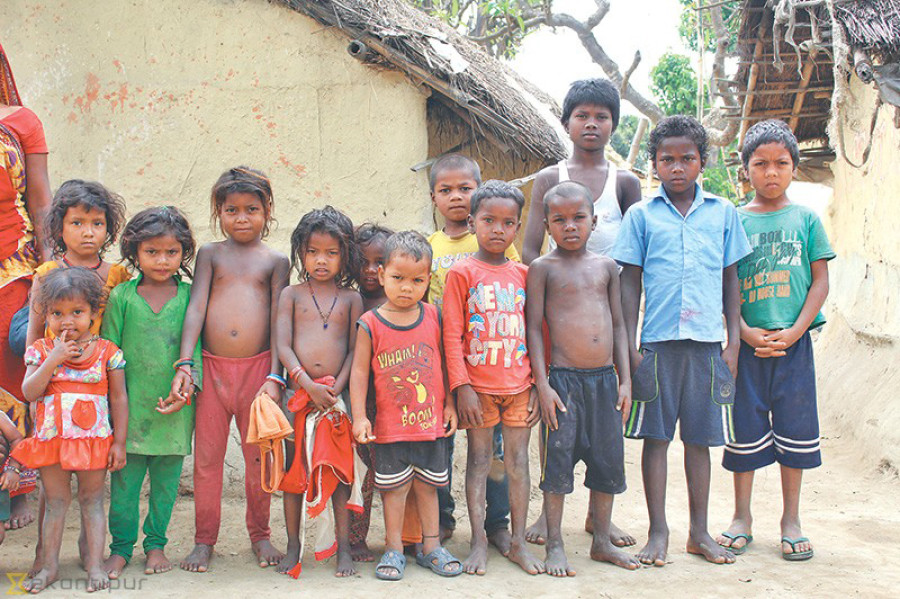Valley
Nepal has made progress in child health, but experts say the country has a lot more to do
The country has achieved huge reductions in child mortality—59 percent decrease since 2000, allowing more children to survive the first five years of life, says a new report
Arjun Poudel
Nepal has made substantial progress in various child health indicators over two decades, but experts say the country still needs to do a lot more.
According to ‘The Global Childhood Report-2019’, published by Save the Children on Tuesday, Nepal has progressed by 142 points in the past two decades and ranks 133rd out of 176 countries based on indicators such as infant mortality rate, access to education, malnutrition, child marriage and child labour.
“Children born in Nepal today have a much better chance of growing up healthy, happy, educated and protected than children born 20 years ago,” stated the report.
The country has achieved huge reductions in child mortality—59 percent decrease since 2000, allowing more children to survive the first five years of life.
In addition, the new national estimates suggest child labour rate in Nepal has slashed by half over a ten-year period, while child marriage rates have been cut by one third in two decades.
“Our report shows that progress for Nepali children has been truly impressive,” Ned Olney, country director of Save the Children Nepal, said in a statement. “For that progress to sustain, we encourage the government to increase investment in targeted interventions for the most vulnerable children, including newborns, early learners, girls, ethnic minorities and Dalits.”
However, Save the Children says too many Nepali children are still missing out on the childhood they deserve. The report also pointed out problems of malnutrition and child labour, which is seen in 36 percent (under five years of age) and 37 percent of children in the country respectively.
“The report shows there is enough room for improvement,” Dr Bikas Lamichhane, former director of Child Health Division, told the Post. “We have to do a lot to make additional progress.”
He said that the government has not been able to implement many of their decisions, which are instrumental in achieving national as well as international commitments.
Without implementing those programmes made by experts, the country cannot make additional achievements.
According to Lamichhane, if things had gone as planned, all birthing centres operating throughout the country would have neonatal care facilities in all district hospitals and neonatal intensive care unit in zonal hospitals.
The government had committed to making these services available, in an effort to reduce existing infant and neonatal mortality rate, some three years ago, but the services are currently available only in a few centers.
The country’s current neonatal mortality rate is 21 per 1,000 live births, and infant mortality rate is 32 per 1,000 live births. The numbers have remained stagnant for the last several years. Moreover, under-five mortality rate at 39 per 1,000 live births has remained constant since 2016.
“We have picked a low hanging fruit easily by simple efforts,” Dr Senendra Upreti, former health secretary, told the Post. “But additional efforts are needed to achieve additional targets.”
He said that the priority of the government should not be changed even in the changed political context. For that the federal government should advocate about the seriousness of the health programmes to the provincial as well as the local level governments.
Challenges have increased, as the Child Health Division has been transformed into Child Health and Immunization Section at the Family Welfare Division, which is also under the Department of Health Services.
The budget and programmes of child health have also been transferred to provincial governments.
Dr Jhalak Sharma, chief of the Child Health and Immunization Section of the Family Welfare Division under the Department of Health Services, conceded that the concerned agencies under the Health Ministry, including his office, were unable to increase the immunisation coverage, make progress on nutrition status, and reduce existing neonatal, infant and under-five mortality rate.
“We are serious about those indicators and have been working to improve them,” said Dr Sharma.
The Save the Children report was launched on the eve of International Children’s Day which is observed on June 1.
The report also includes the annual End of Child Index, which finds that circumstances for the child have improved in 173 out of 176 countries since 2000.
The report states 4.4 million fewer child deaths per year globally, 49 million fewer stunted children, 130 million more children in school, 94 million fewer child labourers and 11 million fewer girls forced into marriage or married early.
Singapore tops the rankings as the country that best protects and provides for its children, with eight Western European countries and South Korea also ranking in the top 10.
The most dramatic progress was among some of the world’s poorest countries, with Sierra Leone making the biggest improvements since 2000, followed by Rwanda, Ethiopia and Niger, says the report.
The Central African Republic ranks last with Niger—despite recent progress—and Chad rounding out the bottom three countries where childhoods are most threatened.




 7.34°C Kathmandu
7.34°C Kathmandu











